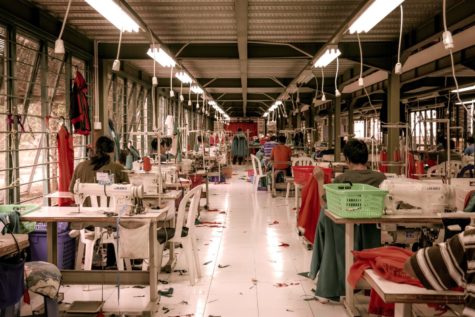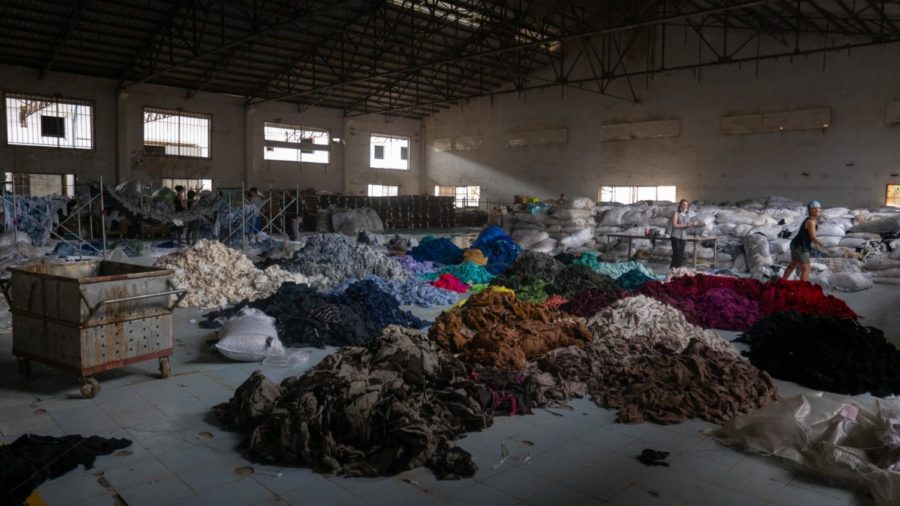The Role of the Internet in Fast Fashion
The increasingly disposable nature of clothing, a problem that social media is only exacerbating.
Masses of discarded clothing lie in an abandoned factory in Cambodia.
Fashion has never existed in a vacuum; it has always been influenced by outside and environmental factors like members of one’s immediate community and neighboring cultures. However, now that the internet permeates every level of our society, its sphere of influence has expanded considerably. Now, fashion that is popular in one part of the world can go viral and become a global phenomenon.
The recent explosion in popularity of Birkenstock clogs is a prime example of this phenomenon. The beige “potato shoes” went viral on TikTok over the summer and are now sold out everywhere. While the rise of Birkenstock clogs stemmed partially from American celebrities such as Kendall Jenner and Emma Chamberlain wearing them, their popularity on TikTok meant that they were sold out on their website and in stores around the world.
Once they reached virality, not only were all the Birkenstock stores sold out, but second-hand sellers were able to charge exorbitant prices due to the shoes’ surge in popularity. Some consumers did not want to wait for the stores to restock, nor pay inflated prices for shoes they were not extremely connected to. Many people turned to the cheaper, faster option: knockoffs, or as they are called on the internet, dupes. Dupes are created to look like the original and reach the consumer within the window of popularity.
Most of the clothing that has become extremely popular is in some sense affiliated with fast fashion; they are either unsustainable, low-quality pieces, or, even if they are made sustainably, the window of popularity surrounding them is so narrow that the garments fall into the former category. In order to capitalize on that window, fast fashion companies make dupes. While the Birkenstocks are high quality and environmentally friendly, the same cannot be said for other viral items and their dupes.
Fast fashion companies such as SHEIN produce clothing that is made to be thrown out at the season’s end, as their clothing is cheaply made and inexpensive to purchase, making many turn a blind eye to the issues with the brand and others like it, ethically and environmentally.
The materials are synthetic and are thus not biodegradable, meaning masses of lightly worn clothing gets dumped into landfills, where they will sit for over 200 years before the materials decompose, seeping into the Earth. They get into the water systems and cause pollution. Fast fashion has an immense negative impact on the environment, with fabric dyeing having the worst environmental impact of most industries, and it is being consumed at a rate like nothing before.

In addition to the shoddy materials needed to maintain low prices, SHEIN does not pay its workers unless they produce at least 500 garments per day. Once they hit that quota, the garment makers are paid only 3p per piece. This structure forces them to work inhumane hours in order to reach their quotas, lest they not be compensated at all.
TikToks of massive, $800 clothing hauls in which influencers show off the new apparel they bought from SHEIN or other ultra-fast fashion brands have become extremely popular, with 7 billion views as of October 2022. The rate at which clothing was being consumed in this popular trend, as well as others like it, contributes to the fast-paced nature of fashion trends. TikTok and social media as a whole have shaped consumer habits, leading to a rise in the fashion phenomenon known as “micro trends.”
Fashion has always moved in trend cycles, but with the rise of social media, micro trends make these cycles considerably shorter. Where trends used to last years, micro trends last months or even weeks. This is all a result of the hyper-consumerism that TikTok encourages.
Consumers often buy clothing and items unnecessarily because doing so releases dopamine and provides enjoyment. This unnecessary spending on non-essential goods surged during the Coronavirus pandemic, when lives were more constricted than before and many people were depressed and unable to leave their homes. Many people turned to TikTok for comfort and an escape from reality.
In addition to its extremely effective algorithm that provides targeted and addictive content, TikTok encourages its users to become creators. With the simple process of creating a video and the chance of virality in reach, it is easy to become enthralled by the platform, adding to the pressure of over-consumption by amplifying the internal and societal pressures — because everyone can become an influencer.
The app collects massive amounts of user data, which feeds into its algorithms to serve up incredibly addictive content. While the captivating nature of the platform is enjoyable when the algorithm provides interesting content, when that data is being sold to advertisers to market specific ads to influence buying behavior, it is much scarier.
Advertising has become insidious because of the age of social media. Large companies like SHEIN are using social media to get creators to promote their products. In a survey that I conducted of high school and college-age students consisting of 37 participants, 73% of respondents said their fashion choices were inspired by TikTok and/or Pinterest. Some of the massive SHEIN hauls that were presented on creators’ pages as just something of interest to both them and the users were, in reality, sponsored by SHEIN. The discreet nature of the advertising thus incentivizes the consumer to buy their product by sharing the idea through the mouth of someone they trust, a creator they feel like they know. It no longer appears as just a soulless advertisement the user can ignore. This makes the marketing of these brands even more effective. After all, people are very impressionable, more so than we realize.
People have always sought value through their material goods, and as such, there is pressure, especially for content creators, to keep up with trends in order to stay relevant. This heightens the need to buy large amounts of clothing, most of which will go to the landfill in a matter of months. But even those who are not creators feel the effects of over-consumption. They also follow those trends. When one sees an influencer they admire hawking the latest trends, it compels them to rampant consumption in order to follow suit.
While many have tried to raise awareness and call for change in the industry, the negative impacts and intentions of fast fashion are clear and here to stay. Social media has amplified our rampant hyper-consumerism, allowing the cycles of fast fashion to intensify. Social media drives us to consume more to stay relevant in ways never seen before. It is clear that social media has ushered in a new age of consuming clothing, and it will continue to affect our behavior and methods of consumption for years to come.
However, now that the internet permeates every level of our society, its sphere of influence has expanded considerably. Now, fashion that is popular in one part of the world can go viral and become a global phenomenon.
Yardena Franklin is a Chief Graphic Designer and Editor-in-Chief for ‘The Observatory’ yearbook, as well as a Staff Reporter for ‘The Science Survey’...

